

What is Conformity? What is Conformity?
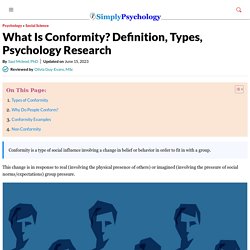
By Saul McLeod, updated 2016 Conformity is a type of social influence involving a change in belief or behavior in order to fit in with a group. This change is in response to real (involving the physical presence of others) or imagined (involving the pressure of social norms / expectations) group pressure. Conformity can also be simply defined as “yielding to group pressures” (Crutchfield, 1955). Group pressure may take different forms, for example bullying, persuasion, teasing, criticism, etc. The term conformity is often used to indicate an agreement to the majority position, brought about either by a desire to ‘fit in’ or be liked (normative) or because of a desire to be correct (informational), or simply to conform to a social role (identification). Jenness (1932) was the first psychologist to study conformity. He asked participants individually to estimate how many beans the bottle contained. Social Psychology and Influences on Behavior.
What you’ll learn to do: recognize aspects of social psychology, including the fundamental attribution error, biases, social roles, and social norms, in your daily life Social psychology is the study of how people affect one another’s thoughts, feelings, and behaviors.
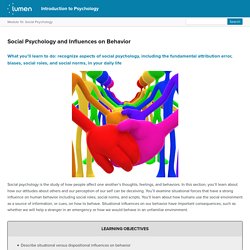
In this section, you’ll learn about how our attitudes about others and our perception of our self can be deceiving. You’ll examine situational forces that have a strong influence on human behavior including social roles, social norms, and scripts. You’ll learn about how humans use the social environment as a source of information, or cues, on how to behave. Situational influences on our behavior have important consequences, such as whether we will help a stranger in an emergency or how we would behave in an unfamiliar environment. Learning Objectives Social psychology examines how people affect one another, and it looks at the power of the situation. Figure 1. Examples of Conformity in the Workplace. You Might Be Guilty of This Workplace Habit and Creativity Killer. Turns out, there's a business need for the office rebel.

Stay informed and join our daily newsletter now! October 27, 2016 4 min read On good days, being a team player means cooperating and collaborating. On tough days, it can mean going along with a decision you disagree with for the greater good. But most days, being a team player can mean something else entirely -- something you haven’t considered. That’s the dark side of and one that has big impacts for careers and businesses. Related: 11 Pieces of Rebel Advice That Will Catapult Your Startup Success. Examples of Conformity in the Workplace. Organizational Behavior and Human Relations. Learning Outcomes Examine how individuality and conformity work together in the modern workplaceDescribe how companies narrow the range of acceptable behavior Diversity and individuality are vital components of today’s workforce.
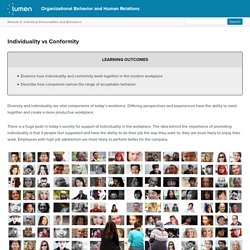
Differing perspectives and experiences have the ability to meld together and create a more productive workplace. There is a huge push in today’s society for support of individuality in the workplace. The idea behind the importance of promoting individuality is that if people feel supported and have the ability to do their job the way they want to, they are more likely to enjoy their work. How Does Conformity Apply to the Workplace? - Conformity in the Workplace. Theories into practice corporate social responsibility Corporate social responsibility (CSR) is a self-imposed organizational commitment to charitable partnerships, environmental protection, efforts for fostering sustainable growth, and community- based development.
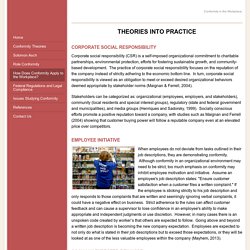
The practice of corporate social responsibility focuses on the reputation of the company instead of strictly adhering to the economic bottom line. In turn, corporate social responsibility is viewed as an obligation to meet or exceed desired organizational behaviors deemed appropriate by stakeholder norms (Maignan & Ferrell, 2004). Stakeholders can be categorized as: organizational (employees, employers, and stakeholders), community (local residents and special interest groups), regulatory (state and federal government and municipalities), and media groups (Henriques and Sadorsky, 1999). Employee initiative. Everyone's Confused In Meetings But No One Asks Questions - Here's What Needs to Change.
Picture this: You're in an important meeting with senior leadership.

The CEO is sharing the firm's strategic plan, including how the company will "leverage big data to gain visibility into market opportunities producing measurable ROI". Um...what? You do a quick scan around the conference room. Heads nod in agreement as the CEO concludes. Self-doubt kicks in. Later while grabbing coffee, a colleague divulges that they were lost amidst the jargon. Is this simply irony–or is something more at play? This phenomenon is called pluralistic ignorance. Pluralistic ignorance is surprisingly common in the workplace–from the boardroom to how we evaluate our personal success.
Behavioral economist Dan Ariely brilliantly demonstrates pluralistic ignorance in action with a clever stunt on his unassuming undergrads. How to Break The Silence And Speak Up At Work. Pub26. How Situations Influence Personality. Note: This post was originally published as part of the Deloitte Australia Diversity and Inclusion monthly newsletter, and can be accessed here.
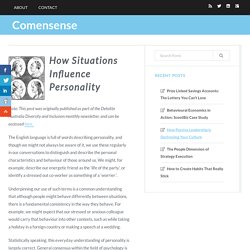
The English language is full of words describing personality, and though we might not always be aware of it, we use these regularly in our conversations to distinguish and describe the personal characteristics and behaviour of those around us. We might, for example, describe our energetic friend as the ‘life of the party’, or identify a stressed out co-worker as something of a ‘worrier ‘. Underpinning our use of such terms is a common understanding that although people might behave differently between situations, there is a fundamental consistency in the way they behave. For example, we might expect that our stressed or anxious colleague would carry that behaviour into other contexts, such as while taking a holiday in a foreign country or making a speech at a wedding. Aim Method Findings Three main findings were identified: Implications For Managers.
The Prime Difference: Situational Vs. Dispositional Attribution - Psychologenie. Attribution Theory - Situational vs Dispositional. Attribution Theory By Saul McLeod, published 2012.
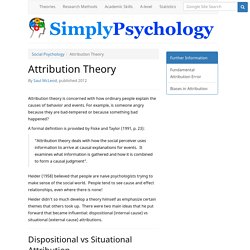
The dangers of Conformity at the workplace for both workers and employers and in the end society…